
Windows and doors have played an integral role in the architectural tapestry of civilisations throughout history. As we trace their journey from the classical designs of ancient cultures to the contemporary innovations of today, we discover a fascinating evolution that reflects the social, technological and aesthetic changes that have shaped our world.
- Windows in Antiquity:
In ancient times, windows were more useful than decorative. The Egyptians used small openings covered with animal skins to let in light while maintaining privacy. The Greeks and Romans elevated window design with the use of glass, albeit in small panes due to manufacturing limitations.
- Medieval elegance:
The Middle Ages saw the emergence of Gothic architecture, characterised by pointed arches and large, intricate stained glass windows. These majestic windows in cathedrals and castles not only served functional purposes but also became symbolic expressions of religious and social narratives.
- Renaissance Revival:
During the Renaissance, a renewed interest in classical Greek and Roman architecture led to certain window and door features reviving. Arched windows and large, columned entrances became popular, reflecting a return to classical ideals and proportions.
- The Age of Enlightenment:
The 17th and 18th centuries saw a move away from the ornate styles of the Renaissance. Simplicity and symmetry became the hallmarks of design during the Age of Enlightenment. Windows featured divided light patterns and smaller panes, while doors became more refined with detailed mouldings.
- Industrial Revolution and technological advances:
The 19th century they marked a significant change with the Industrial Revolution. Mass production allowed window and door components to be standardised, making them more accessible. The Victorian era embraced eclectic design, combining different historic styles to create unique, ornate structures.
- Modernist simplicity:
As the 20th century dawned, the modernist movement ushered in a new era of simplicity and functionality. Large, unadorned windows became a staple of modern architecture, emphasising the connection between indoor and outdoor spaces. Sliding glass doors and expansive picture windows defined the mid-century modern aesthetic.
- Contemporary Innovations:
In the 21st century, technology has changed the way we approach window and door design. Energy-efficient materials, smart home integration and sustainable practices have become priorities. Contemporary architecture often features floor-to-ceiling windows, sleek sliding doors and innovative materials that prioritise both aesthetics and efficiency.
Conclusion:
The historical evolution of windows and doors reflects the ever-changing landscape of human civilisation. From the simplicity of ancient openings to the sophisticated designs of the modern era, these elements have evolved not only in form and function but also as an expression of cultural, societal and technological progress. As we continue to innovate, today’s windows and doors bridge the gap between history and the future, preserving a legacy of design that is a testament to human ingenuity and creativity.
